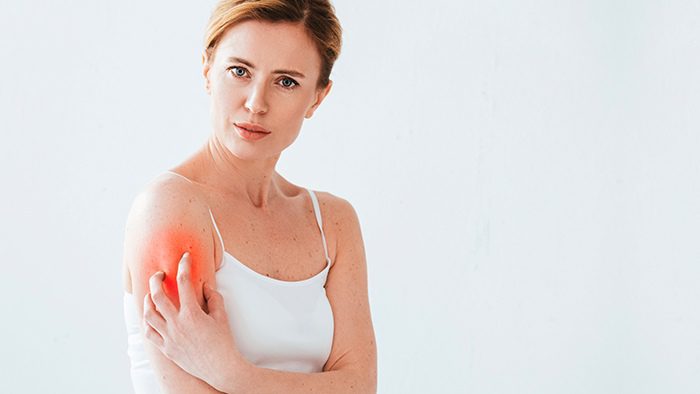Eczema and Urticaria are two different manifestations of a skin allergy, but the main symptom is pruritus (itching). In eczema, there is generally a so-called contact form, caused directly by an allergenic external substance (treated in the chapter on contact allergies) and a more complex form, called eczema or atopic dermatitis, which develops chronically.
ATOPIC DERMATITIS, WHAT IS IT?
Atopic dermatitis is a disease of chronic inflammation of the skin, common during the first years of life. It’s about one of the first manifestations of atopy which makes it possible to distinguish a population of children at high risk of allergic manifestations respiratory later. Atopic dermatitis therefore primarily affects people with an atopic predisposition. By atopic, we hear a violent and overreaction (an allergy) to common substances encountered in the context of daily life, and which are perfectly tolerated by a person in good health, in which they do not trigger the disease. This hypersensitive reaction can have placed on the skin (dermatitis or atopic eczema), in the mucous membranes (hay fever, allergic conjunctivitis), bronchi, or lungs (allergic asthma). Several of these manifestations of atopy can be associated in the same person, sometimes with different times of its existence.
The frequency of atopic dermatitis has increased in recent decades, rising from 2-3% to almost 10% of children in Western countries. However, these figures vary considerably from country to country. In half of the cases, atopic dermatitis in children begins during the first year of life and in 2/3 of cases before the age of 7. However, there are later forms, showing during puberty or adulthood. When the disease starts early, the prognosis is favorable: by the age of 11, 60% of children no longer have lesions active and 70% by the age of 23.


Several factors are involved in triggering dermatitis atopic, which is of multifactorial origin:
• Strictly speaking allergic factors. Certain substances present in the environment, for example, pollens, animal hair, mites contained in household dust, and certain dietary factors in infants and young children (cow’s milk, eggs, soy, and wheat flour), are sometimes implicated (they are called allergens, causing allergy). It is sometimes difficult to determine exactly the responsibility of these substances in triggering lesions of atopic eczema, especially for forms moderate or mild. However, in patients allergic to dust mites, a significant decrease in skin lesions has been observed when avoidance measures were applied, compared to patients who did not change their environment.
• Significant skin dryness. This phenomenon is still poorly understood, but the composition of the hydrolipidic film normally covering the skin is altered in atopic subjects. This results in dry, more fragile skin, less protective against the external environment, and more easily subject to pruritus (itching). Recent data suggests that in a number significant number of atopic subjects, this skin dryness would be due to minimal mutations of certain genes encoding skin proteins (especially profillagrin) responsible for the proper hydration of the layer epidermal cornea.
• The presence of a bacteria on the skin, Staphylococcus aureus. 90% of patients with atopic dermatitis are colonized by Staphylococcus aureus, contrary to healthy subjects. Staphylococci aureus are the cause of secondary infections skin but can cause eczema flare-ups on their own.
All in all, there is a vicious circle that sustains the symptoms: dry skin and eczema flare-ups induce the need to scratch (pruritus), and scratching induces skin lesions that promote superinfection with Staphylococcus aureus, penetration allergens in the skin, aggravate skin dryness, the manifestations allergic and the feeling of itching. This situation also generates large stress for the child and his parents, further aggravating the situation.
WHAT ARE THE SIGNS OF ATOPIC DERMATITIS?
Atopic dermatitis is a chronic disease that progresses in flare-ups, with dry skin on which eczema lesions periodically appear. There are several signs which, together, make it possible to make the diagnosis of atopic dermatitis.
SYMPTOMS
There are several signs which, together, make it possible to make the diagnosis of atopic dermatitis:
• Severe itching, which often leads to insomnia (for the child and his parents!).
• Skin dryness, with sometimes thickened skin
• Eczema lesions: red, oozing skin located on the face, neck, folds flexion of arms and legs, feet, and hands. In infants, eczema is found mainly on the face and scalp
• Other skin signs: double folds on the eyelid, pale face, shadows around the eyes
WHAT TESTS TO DO IN CASE OF ATOPIC DERMATITIS?
There is no laboratory test to make the diagnosis of atopic dermatitis because the diagnosis is essentially clinical. If an atopic land (predisposition for allergies) is suspected, allergy tests (skin tests and/or blood tests) may be helpful. Also, if you suspect that an allergy may play a role in exacerbations of atopic dermatitis, an assessment of allergic reactions may be useful for allergen elimination measures by cause. This is particularly necessary in cases of severe atopic dermatitis or resistance to treatment.
HOW IS ATOPIC DERMATITIS TREATED?
It is important to take into account the different factors involved in this disease to control it as well as possible. The two main principles are to prevent eczema flare-ups by interrupting the infernal itching-scratching cycle, and treat eczema flare-ups quickly and effectively when they occur. All these measures lead to the reduction of pruritus and provide great relief for people affected.
Prevent eczema flare-ups:
• Hydration of the skin. Proper hydration of the skin is the basis of preventive treatment for atopic dermatitis and should be continued even when the eczema lesions have diminished or disappeared. Hydration is achieved through emollient creams applied to the skin as often as needed. Baths in not too hot water for a maximum of 20 minutes or showers help moisten the skin. Emollient bath oils can also be used. For drying, avoid rubbing the skin, but rather dab it in order to retain all the moisture, then quickly coat it with a fatty substance (within 3 minutes of coming out of the water).


• Avoid irritants. Irritants should also be avoided when wearing pay attention to detergents used without using softeners, and to clothes that will preferably be cotton. It is important not to use aggressive soaps for the skin, as they worsen the irritation and dryness of the skin.
• Removal of allergens. These measures can be useful when the responsibility for allergens has been formally proven, which is rarely the case. When a food allergy has been formally identified, a diet eviction will be followed. Dietary advice must be given precisely to parents, with the help of the dietician, if necessary. It is very important to avoid excessively strict exclusion regimes and ensure that there is no deficiency food, which can affect the growth and development of the child. The elimination of indoor air allergens (animal hair and mites) is especially necessary to prevent the further development of respiratory allergy. For dust mites, the purchase of an anti-dust mite mattress cover, as well as temperature and humidity control (a warm environment and moist promotes mite growth), are the most effective.
Treat eczema flare-ups:
• Treat inflammation with topical corticosteroids. Corticosteroids external application are the most effective drugs to control acute flare-ups of eczema. The fear of the adverse effects of Topical corticosteroids are unfounded if used correctly. These have been classified according to their anti-inflammatory power of class 1 (weak activity) to class 4 (very strong activity), which allows choosing the appropriate substance. For the same substance, the ointment has higher occlusive power and is, therefore, more potent than cream. On the face, it is preferable to apply only topicals of class 1 or 2, because the skin is more sensitive and particularly exposed to complications. The gluteal region in children is also a risk area. The application is initially done once a day for a few days, then it is necessary to gradually space out the rhythm of the applications. You must not suddenly stop the application, but rather wean gradually to avoid the early recurrence of acute lesions. Other local anti-inflammatory treatments that do not contain corticosteroids are now marketed (topical pimecrolimus and tacrolimus). These are creams that appear to be as effective as topical corticosteroids, and there appear to be few side effects, especially after prolonged applications over long periods of time; however, their cost is higher. These creams are therefore reserve for special situations, in case the conventional treatment by topical emollients and corticosteroids would not be effective enough, or if it side effects of these treatments occurred.
• Treatment of the secondary infection caused by Staphylococcus aureus. Due to the importance of colonization of the skin by Staphylococcus aureus and its potential role in the exacerbation of eczema lesions, antibiotic cream treatment is often indicated. Oral antibiotics can also be used in case of a more severe infection.
• New treatments for severe forms. Research is advancing in understanding the disease, which allows the development of new treatments more targeted on the inflammatory reaction abnormal seen in atopic dermatitis. Administered by subcutaneous injection or orally, they are currently reserved for severe forms in adults but their use will probably be extended to children in the future.
• Therapeutic education to improve care. It is often difficult for parents and children with the disease to understand the disease, accept its chronic nature and make good use of local treatments. Therapeutic education is a new approach that improves efficient processing. It is first done in the office of the pediatrician and the dermatologist who will explain to the child and parents what atopic dermatitis is, how to recognize a flare-up and treat it. Therapeutic education can sometimes call for specialized structures, often in a hospital environment called the atopy school.
Major guidelines for the treatment of atopic dermatitis:
Prevention of eczema flare-ups
• Supplying the skin with moisture
• Elimination of allergens (nutrition, mites …)
• Avoiding irritants to the skin
Treat the relapses early and effectively
• Topically applied corticosteroids
• Anti-staph cream
URTICARIA
WHAT IS URTICARIA?
Urticaria is a skin allergy that is the release of a substance, histamine, in the skin. The histamine released causes intense itching and superficial redness of the skin. There are different causes for the release of histamine in the skin: allergic and drug causes, physical causes, food causes, and internal causes. These causes are globally similar to the causes of angioedema, and these two forms of allergies are sometimes associated. In most cases, urticaria heals spontaneously within a few weeks and there is not necessarily a need to do laboratory tests. If there is still the appearance of new lesions after 6 weeks, this is called chronic urticaria, and some tests are sometimes necessary to determine the cause.
SYMPTOMS
• Significant itching
• Red, sometimes hardened spots on the skin that are less stop for more than 24 hours and without scars disappear
• Keep appearing new temporary lesions over several days, even several weeks
WHAT ARE THE CAUSES OF URTICAIRE?
Urticaria can be of allergic or drug origin and requires then specialized allergological investigations (discussed in the chapter on acute allergies, angioedema).
In addition, we distinguish other forms urticaria:
• Urticaria of physical origin. Different physical factors can cause urticaria lesions: cold, heat, water, pressure. A particular form is what is called dermographism: the appearance of urticaria lesions within one to two minutes on the site or on the skin was rubbed.
• Stress urticaria, or cholinergic urticaria. The appearance of small lesions very itchy hives after exertion, stress, or heat.
• Urticaria from internal causes. Certain parasitic infections, certain thyroid diseases, or autoimmune diseases can manifest as hives. In this case, the urticaria is rather chronic.
• Contact urticaria. Certain allergenic substances (eg latex) can cause directly by urticaria lesions at the contact site.
• Chronic idiopathic urticaria. This type of urticaria is very common, accounting for about three quarter of patients with this symptom. Idiopathic means that there is no internal cause or external hives, which can last a long time. Most cases regress spontaneously within 2 years, but symptoms may persist for 10 years or more in about 20% of patients.
WHAT IS THE TREATMENT FOR URTICARIA?
When an allergic or food cause is determined, which is not always the case, the elimination of the allergen or the offending food helps prevent a recurrence. The main treatment is to block the effect of histamine while taking medicines called antihistamines. There are many types antihistamines, but these drugs have no side effects and can be taken for several weeks without problem. In some cases, and especially for the strongest antihistamines old, they can induce drowsiness and in this case it is better to take them in the evening and avoid To drive. For chronic forms resistant to antihistamines, new treatments sometimes acting more directly on the immune system are used.










0 Comments